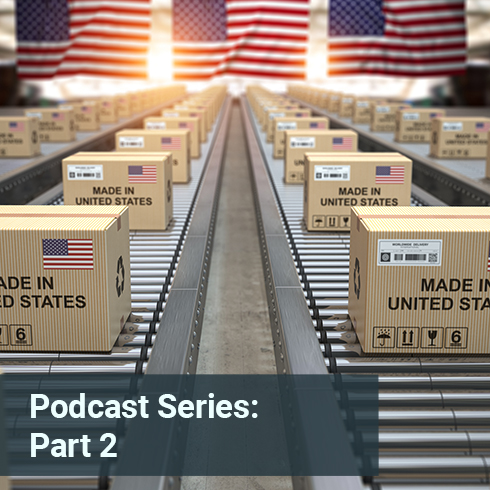Is Your Organization Poised to Take Advantage of More Business-Friendly Policies?
There are companies that make things happen, those that watch what happens, and those who wonder what happened. Proactive preparation is the key to avoid being in one of the latter two groups. And with several tax, regulatory, and policy changes headed our way, now is definitely a good time for companies to start making plans for the actions they want to take when those changes do come down. We interviewed Bryan Ball , Vice President and Principal Analyst for Supply Chain Management at Aberdeen Group, to gather insights on pressing issues related to changes in policy.
The recent supply chain readiness research we conducted with Aberdeen Group reveals that manufacturers are optimistic about the potential impact of the changes ahead. But it also shows that most companies could be better prepared. An operational readiness plan can ensure your business is in a position to take full advantage of the benefits of changes when they occur.
Of course, no one knows for certain yet what, exactly, the future business landscape will look like. But experts and industry leaders have a pretty good idea about the nature of some key proposed policy changes. Based on these anticipations, here are a few steps you can take now to improve your operational readiness.
If and when the corporate tax rate drops:
Your business is going to have more money on its hands. But so will your existing competitors. New competitors may also arrive on the scenes when the business climate becomes friendlier in the U.S. Considering your investment plans and growth strategy now, and lining up the resources you need to execute those plans, will help your business be one of the first to respond.
Some key questions to consider:
- Will you make or buy? With more money available for investment, will your business increase its own output? Or does it make more sense to acquire another existing business? Consider where your best opportunities for growth exist, and then create a plan for how you will capitalize on them.
- Is your footprint right? If you plan to grow, now’s the time to ensure you have the right capacity and to consider where you want to ramp up. What specific investments in equipment and technology will you will need to make in order to achieve your goals? Doing the legwork now will help expedite these transactions when the time is right.
- Do you have the right people in place? Our research shows that most companies feel their S&OP processes are ready to respond to changes. However, the biggest challenge in this area is people. Best-in-class manufacturers are particularly concerned about having the right talent in place to help them respond to changes on the horizon. Now may be the time to consider onboarding S&OP experts or to look into how consultants can help you maximize the effectiveness of these and other key supply chain processes.
If and when global trade policies change:
While most manufacturers believe corporate tax rate changes will have the biggest impact on their business moving forward, best-in-class manufacturers are more focused on trade issues. This may be because they are more likely to have global supply chains and operations. In any case, trade policy changes are expected to make it more favorable to do business in the U.S. and potentially less attractive to have operations in places like Mexico or China. If your organization is heavily invested in these countries, you need to be thinking now about bringing operations back to the U.S.
No matter where you operate, it’s a good idea to:
- Dust off your supply chain network design tools. If network design is something you typically look at once a year or less, it may be time to start considering it more frequently. Working with the right network design partner can help ensure your factories, DCs, and key suppliers are located in the right places to cost-effectively meet customer demand based on U.S. trade policy changes.
- Invest in global trade management software—or partner with someone who does. As shifts in global trade policies occur, the best way to keep up with them and identify the most advantageous places to do business is to have access to global trade management software. These types of tools analyze the impact of trade agreements and keep track of the duties, tariffs, and regulations involved with doing business in specific countries. In other words, they help you know sooner rather than later where the best opportunities exist. Companies that try to wade through all of the information on their own will likely miss the boat when it comes to staking their claims in the most favorable locations.
If and when energy costs drop:
This will make it even more advantageous to do business in the U.S. If your business operates highly automated plants overseas, these may be the first operations you should consider bringing back home. Energy savings combined with tax advantages will likely offset any additional labor costs. So companies should at least give serious consideration to bringing their high-tech operations back on shore.
Planning can’t wait.
Yes, there is still much uncertainty about what exactly the business environment will be like in the months and years ahead. But businesses can’t afford to wait to start making operational readiness plans. Things like changing your network design, investing in new equipment or facilities, and bringing overseas operations back onshore don’t happen overnight. Making an operational readiness plan now in anticipation of expected tax, trade, and policy changes will put you in a position to pull the trigger and execute quickly if and when those changes do come to fruition. And, as we like to say at TBM, speed wins every time.
Learn more about supply chain readiness.
Our new Supply Chain Readiness Research report provides details on the potential impact of impending governmental trade policy, tax reform, and regulatory changes along with insights on the readiness of manufacturing companies to respond to such changes.





